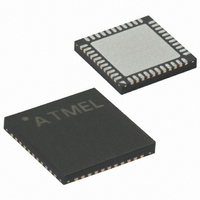ATMEGA644P-A15MZ Atmel, ATMEGA644P-A15MZ Datasheet - Page 187

ATMEGA644P-A15MZ
Manufacturer Part Number
ATMEGA644P-A15MZ
Description
MCU AVR 64KB FLASH 16MHZ 44QFN
Manufacturer
Atmel
Series
AVR® ATmegar
Specifications of ATMEGA644P-A15MZ
Package / Case
44-VQFN Exposed Pad
Voltage - Supply (vcc/vdd)
2.7 V ~ 5.5 V
Operating Temperature
-40°C ~ 125°C
Speed
16MHz
Number Of I /o
32
Eeprom Size
2K x 8
Core Processor
AVR
Program Memory Type
FLASH
Ram Size
4K x 8
Program Memory Size
64KB (64K x 8)
Data Converters
A/D 8x10b
Oscillator Type
Internal
Peripherals
Brown-out Detect/Reset, POR, PWM, WDT
Connectivity
I²C, SPI, UART/USART
Core Size
8-Bit
Lead Free Status / RoHS Status
Lead free / RoHS Compliant
Available stocks
Company
Part Number
Manufacturer
Quantity
Price
Company:
Part Number:
ATMEGA644P-A15MZ
Manufacturer:
ATMEL
Quantity:
3 500
Part Number:
ATMEGA644P-A15MZ
Manufacturer:
ATMEL/爱特梅尔
Quantity:
20 000
- Current page: 187 of 377
- Download datasheet (7Mb)
17.9.3
7674F–AVR–09/09
Asynchronous Operational Range
The recovery process is then repeated until a complete frame is received. Including the first stop
bit. Note that the Receiver only uses the first stop bit of a frame.
Figure 17-7 on page 187
of the start bit of the next frame.
Figure 17-7. Stop Bit Sampling and Next Start Bit Sampling
The same majority voting is done to the stop bit as done for the other bits in the frame. If the stop
bit is registered to have a logic 0 value, the Frame Error (FEn) Flag will be set.
A new high to low transition indicating the start bit of a new frame can come right after the last of
the bits used for majority voting. For Normal Speed mode, the first low level sample can be at
point marked (A) in
delayed to (B). (C) marks a stop bit of full length. The early start bit detection influences the
operational range of the Receiver.
The operational range of the Receiver is dependent on the mismatch between the received bit
rate and the internally generated baud rate. If the Transmitter is sending frames at too fast or too
slow bit rates, or the internally generated baud rate of the Receiver does not have a similar (see
Table 17-2 on page
frames to the start bit.
The following equations can be used to calculate the ratio of the incoming data rate and internal
receiver baud rate.
D
S
S
S
R
F
M
slow
(U2X = 0)
(U2X = 1)
Sample
Sample
RxD
R
slow
Sum of character size and parity size (D = 5 to 10 bit)
Samples per bit. S = 16 for Normal Speed mode and S = 8 for Double Speed
mode.
First sample number used for majority voting. S
for Double Speed mode.
Middle sample number used for majority voting. S
S
is the ratio of the slowest incoming data rate that can be accepted in relation to the
receiver baud rate. R
accepted in relation to the receiver baud rate.
=
M
---------------------------------------------
S 1
= 5 for Double Speed mode.
–
Figure 17-7 on page
188) base frequency, the Receiver will not be able to synchronize the
+
D
1
1
D
+
shows the sampling of the stop bit and the earliest possible beginning
2
1
S
S
3
2
+
S
F
4
fast
5
3
is the ratio of the fastest incoming data rate that can be
187. For Double Speed mode the first low level must be
6
7
4
8
ATmega164P/324P/644P
STOP 1
9
5
10
R
fast
(A)
0/1
6
=
0/1
F
-----------------------------------
= 8 for normal speed and S
D
M
0/1
0/1
(B)
= 9 for normal speed and
+
D
1
+
S
2
+
S
S
M
(C)
F
187
= 4
Related parts for ATMEGA644P-A15MZ
Image
Part Number
Description
Manufacturer
Datasheet
Request
R

Part Number:
Description:
Manufacturer:
Atmel Corporation
Datasheet:

Part Number:
Description:
Manufacturer:
Atmel Corporation
Datasheet:

Part Number:
Description:
IC MCU AVR 64K FLASH 44-TQFP
Manufacturer:
Atmel
Datasheet:

Part Number:
Description:
IC MCU AVR 64K FLASH 44-QFN
Manufacturer:
Atmel
Datasheet:

Part Number:
Description:
MCU AVR 64K FLASH 20MHZ 44-TQFP
Manufacturer:
Atmel
Datasheet:

Part Number:
Description:
IC MCU AVR 64K FLASH 40-DIP
Manufacturer:
Atmel
Datasheet:

Part Number:
Description:
MCU AVR 64K FLASH 20MHZ 44TQFP
Manufacturer:
Atmel
Datasheet:

Part Number:
Description:
MCU AVR 64K FLASH 20MHZ 44QFN
Manufacturer:
Atmel
Datasheet:

Part Number:
Description:
MCU AVR 64K FLASH 20MHZ 44-QFN
Manufacturer:
Atmel
Datasheet:

Part Number:
Description:
MCU AVR 64K FLASH 20MHZ 40-PDIP
Manufacturer:
Atmel
Datasheet:

Part Number:
Description:
MCU AVR 64K FLASH 15MHZ 44-TQFP
Manufacturer:
Atmel
Datasheet:











